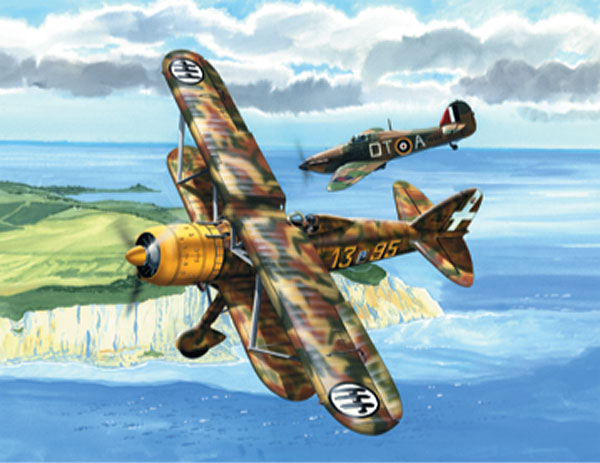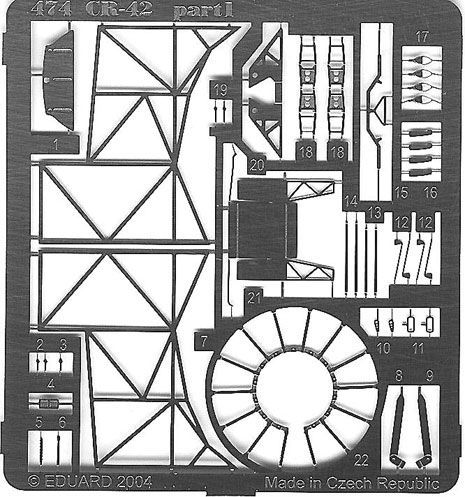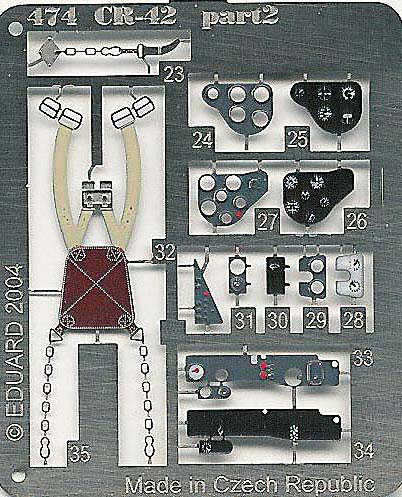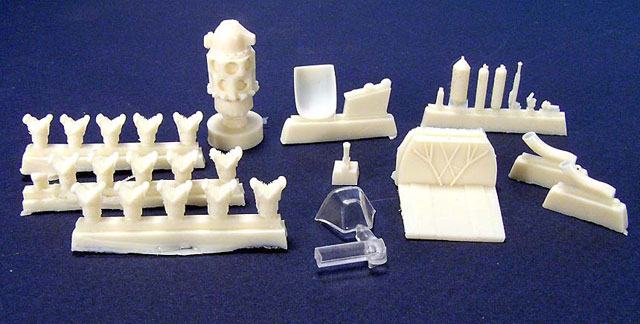|
Fiat CR 42
Regia Aeronautica
& Fiat CR 42 Export

Classic Airframes
S
u m m a r y
|
| Catalogue Number: |
474 (Regia Aeronautica) & 475
(Export) |
| Scale: |
1/48 |
| Contents and Media: |
Both kits - 36 parts in gray styrene, 29 parts in
cream colored resin and 1 clear injection molded windshield.
Instructions, decal sheet and painting guide with markings for 5
aircraft. |
| Price: |
MSRP
USD$40.00 |
| Review Type: |
FirstLook |
| Advantages: |
New tooling, colored etched metal included. |
| Disadvantages: |
|
| Recommendation: |
Highly Recommended |
Reviewed by Steven "Modeldad" Eisenman

Classic
Airframes' 1/48 scale Fiat CR 42 kits may be ordered online from Squadron
There are a couple of fairly common sentiments expressed on
HyperScale about the current state of aircraft modeling. One is that
this is a “Golden Age” of modeling. The other, a bit more critical, is
expressed in the form of a comment as to why did “X” company release
another Fruchtfledermaus when there are five out already, and why
another Luftwaffe aircraft.
As to the first sentiment, I believe to a certain extent, as a 1/48
scale modeler, it is a Golden Age. Seeing the number of recent issues in
the larger scales, I would also think that a Golden Age is emerging for
the large scale modelers. We are seeing numerous new aircraft from both
mainstream and limited run manufacturers.
As to the second sentiment, very few of the new issues, if any at all,
could be considered to be more of the same, and especially more of the
same Luftwaffe aircraft. To list but a few, Defiant, Fiat G. 50, Macchi
200,Curtiss Shrike, Douglas Skynight, PZL 11c and 24, B5N2 Kate with
folded wings, C6N1 Myrt and Ki 115 Tsurugi.
Now Classic Airframes adds to the growing number of new 1/48 kits of
different aircraft with the release of the Fiat CR 42.
I do not consider this to be a reissue of a kit. As was the case with
the Defiant, this CR 42 is a totally new product. Other than the Classic
Airframes brand, it has no relationship with the CR 42 kit that was
produced nearly 10 years ago. Having one of the old kits in my stash, I
opened it to discover that it has more in common with a SMER kit, than
anything produced recently by Classic Airframes. Soon after that old kit
was issued, Ali D’Italia came out with the monograph on the CR 42 and it
was quite clear that the old kit was badly flawed – wings too narrow in
chord and a cowl far too long. But I built one.
Taking out the Ali D’Italia monograph, and setting the new pieces on the
1/48 drawing, they seem to match nearly exactly. At this time, I’ve not
heard that the Ali D’Italia drawings are inaccuarte.
Now to the kit itself. Surprisingly, it looks quite “shake and bake”-
few parts, but of high quality.
The parts are molded in flash free, gray styrene and have finely and
excellently engraved panel lines. The fabric detail on the wings and
fuselage is well done with subdued, yet clearly defined, ribbing. While
the injection gates are small for a limited run kit, there is a bit of
intrusion of the sprue onto some of the parts. You will need to be
careful when removing parts, especially on the wings.
Click the thumbnails below
to view larger images:
The plastic parts provide for two different landing gear
arrangements. There are the fully covered wheels , and there are parts
to make the uncovered wheels. Yes, the gear leg attachment point on the
yoke is to be slightly off-centered. A simple cut at the compression
joint cuff will make the conversion.
One note on the lower wing, it looks oddly chunky, a bit too squat. But
after looking at many pictures and drawings, it actually was squat and
stumpy. As to the wings, they are molded as single span units and the
leading and trailing edges are properly thin.
One will need to be careful with the cowling. It is injection molded in
two halves, top and bottom. The seam is not a seam that exists on the
real aircraft, so it will need careful work to eliminate.
There are two sheets of photo etched metal. One is in the usual, quite
flexible metal and provides the wire harness for the engine and cockpit
framing, and other assorted bits.

But the big news is that for the first time Classic Airframes has
provided pre-painted etched metal parts for the instrument panels, side
consoles and seat harness. The instrument dials are nicely printed on a
black metal panel which is to be glued behind a dark-gray painted
instrument bezel cluster.

But all is not perfect, at least in my opinion. The first problem is the
bumps on the cowl. While they are well molded and very sharp in detail,
I feel they are a little to tall. A simple light sanding should solve
this, without losing the crispness of the edge.
The other problem is the wheels. They are molded as weighted with a
flat. But, I believe they look far too flat. If you are using the wheel
covers, this will not be a problem, as the flat side can be hidden
inside the cover. If you are using the “naked gear legs”, you may want
to add some strip stock on to the bottom and sand into shape.

A note on the slightly off center spinner of the CR 42. According to the
Ali D’Italia monograph, the thrust line of the motor is Zero Degree, 50
Seconds to the left of the fuselage center line and One Degree, 30
seconds down.
Kit 474 – Regia Aeronatica
-
Fiat CR 42
Prototype circa 1937. Aluminum dope, with a green, white and red
tri-color rudder.
-
367 Squadriglia 151 Gruppo, Turin-Caselle,
circa 1939. This si in the standard Fiat scheme of Giallo Mimetico
3 base with spotches of Marrone Mimetico 2 and Verde Mimetico 3. The
underside of Grigio Mimetico. I’ll refer to this scheme as the
“Fiat Scheme”. Note that the camouflage
pattern on the wing top is more of an elongated slash shape.
The rudder has the tri-color markings.
-
95
Squadriglia, 18 Gruppo, 56 Stormo, Belgium, circa Oct.1940. This
aircraft has the “Fiat Scheme” with a yellow cowling and spinner.
Again the camouflage pattern on the wing top is more of a more
elongated slash shape. The rudder has the white cross. The marking
guide mistakenly identifies the aircraft’s base as England. Now
there is an interesting what if !
-
Foligno
Fighter School, circa 1942. This aircraft is in Verde Oliva Scuro
top-side with Grigio Mimetico underside. There are white fuselage
and wing bands, which must be painted on.
-
Training
Center, Milano-Linate Airport, circa 1946. Over all Aluninum dope
with the roundel marking.
Click the thumbnails below
to view larger images:
Kit 475 – Export

-
Belgian Air Force, 3 Escadrille
“Cocottes Rouge”, 11e Groupe, 2 Regiment, circa May 1940. This
aircraft is in the “Fiat Scheme”.
-
Hungarian Air Force, 1st
Regiment, circa 1040-1941. V-204. This aircraft, coded is in a
splinter scheme of Giallo Mimetico 3, Verde Mimetico 3 and Grigio
Mimetico with Grigio Mimetico undersides. I am not sure the color
guide is correct. It may be that the three topside colors are
Hungarian, rather than Italian colors, with the “sand” color being
more tan-brown than the Giallo Mimetico 3 and the gray on the
top-side being darker than the Grigio Mimetico. It appears that the
Hungarian painted a number of their aircraft in this scheme,
including the He 112.
-
Hungarian Air Force, 2/4 Fighter
Squadron, circa 1941. V-234. This aircraft is in the “Fiat Scheme”
with a yellow spinner, cowl and empennage. A picture of this
aircraft seems to show the yellow over the empennage as being thinly
applied with the chevron barely visible on the tail.
-
Hungarian Air Force, 5/1 Squadron, circa 1943. V.211. This aircraft
is a Dark Green (Verde Mimetico?) over Grigio Mimetico. Some
sources report that it had a Dark Blue-Gray (Grigio Azzuro Scuro?)
top-side color. The tail and horizontal stabilizers have the red,
white and green stripes, which must be painted on.
-
Swedish Air Force, Division 3,
Flydflottilj F9, circa March 1942. This aircraft in the “Fiat
Scheme”, with the camouflage pattern on
the wing top more of a more elongated slash shape. This aircraft
carries fuselage art in the form of a boxing “yellow jacket” wasp.
Note: At the time I received this pre-production sample, the decals
for Kit 475 – CR 42 Export were not available.
Click the thumbnails below
to view larger images:
While I may have said that it
looks like a “shake and bake kit”, don’t take my words literally. As
with all limited run kits, you should test fit the parts before you
apply glue. The cockpit looks particularly fiddly with its combination
of resin and etched metal side walls. One should test fit the floor,
before attaching any etched metal. The floor in my kit seemed too
short. It just may have been a bad casting in a pre-run sample.
The Fiat CR 42 was that last single-seat biplane fighter to be produced
by any combatant in WW-2. In addition to the air forces listed on the
markings sheets, the CR 42 also bore the markings of the Luftwaffe, the
RAF and the Iraqi Air Force. I believe Classic Airframes has produced a
splendid little representation of this historic aircraft.
For those modelers who have not yet made a biplane or who fear building
them, this aircraft is a great way to take the plunge, as it has only
two bracing wires, and they are on the outer inter-plane struts.
Highly Recommended.
Thanks to
Classic Airframes for
the review sample.
Classic Airframes
kits are available worldwide through hobby retailers and from
Squadron.com
Review and Images Copyright © 2004 by
Steven "Modeldad" Eisenman
Page Created 10 December, 2004
Last updated 11 December, 2004
Back to HyperScale Main Page
Back to Reviews Page
|
Home | What's
New | Features
| Gallery |
Reviews | Reference
| Forum
| Search